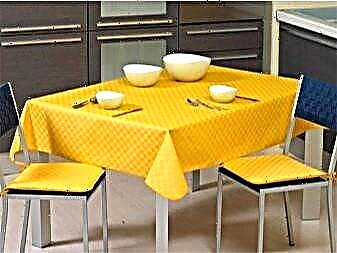Textured, rough curtain fabrics (linen, gunny, velvet, chenille, tapestry) go well with a smooth simple tulle.

To make the interior elegant and not to overload the design of the room, mesh tulle and curtains with embroidery should be complemented with plain smooth curtains.
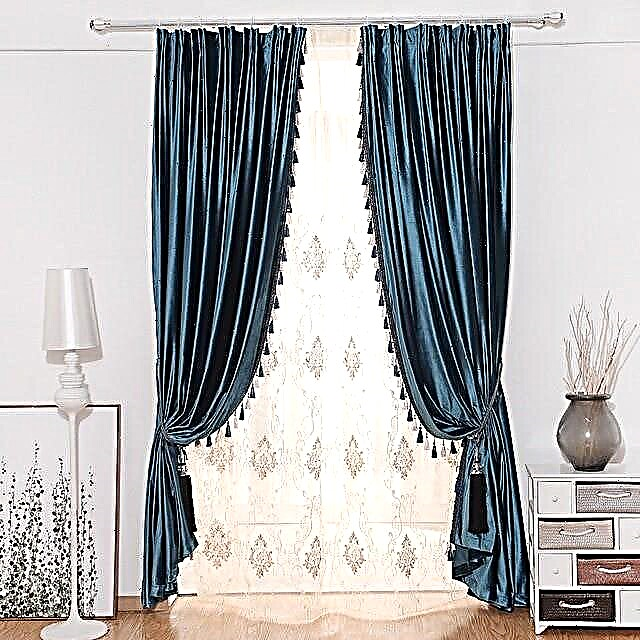
Often a combination of curtains and tulle in the same design is used in the bedroom - that is, where you need excellent dimming. In this case, it is advisable to buy lightproof textiles - blackout, dimout. In fact, this kind of curtains does not need a special tulle - anyone matching with curtain fabric will do.
The size
The second criterion for the harmony of curtains and tulle in the interior is the correspondence of their sizes to each other, as well as the height and width of the window.
It’s easy to calculate the optimal length of the canvas - just measure the distance from the cornice to the floor, then take
5 cm: curtains should not lie on the floor.
For extended models, they sometimes make an exception. Curtains, which folds to the floor, do not always fit ordinary interiors, but look chic in a room in a classic style.

An interesting solution - long curtains and short tulle curtains. Such designs are especially successful in the kitchen and in the room in which the radiators must be left open.
The width of the curtains is even easier to calculate - you need to take into account the assembly coefficient. Usually it is equal to two (if you have a 2 m long cornice, you will need almost 4 m of fabric). Similarly, the width of the tulle is calculated.
In the photo - successful design options for tulle and curtains. Illustrations will help to create ideas about possible stylish combinations of colors and prints on tulle and curtain fabric.
A light curtain and a light tulle are a win-win alliance.

If the light palette seems too boring monotonous to refresh and diversify the interior, try replacing the pastel tulle with a dark one.

Beige, light brown, chocolate curtain and champagne tulle. Other light shades are also suitable - ivory, baked milk, cream, pink.

Purple curtains and a fashionable lilac or pink tulle. Gentle and comfortable.

Bright green curtains and white, yellow, light green tulle. The brighter the curtain, the brighter the tulle can be.

Curtains with a pattern or print. Such models are suitable only monophonic light tulle curtains.
Choose curtains with tulle
But the design of the window opening sometimes plays a decisive role in the decoration of the room. Even perfectly combined surface colors, matching furniture and decor items, high-quality, beautiful textiles and soft upholstery will not “play”, but will lose their attractiveness and charm with an improperly designed window.
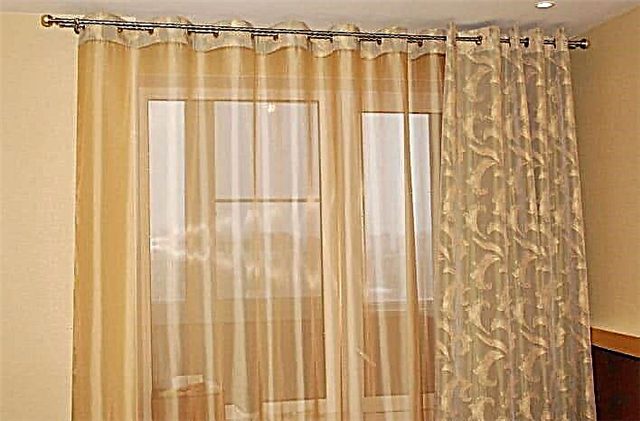
Tulle and curtains regulate the illumination of the internal space, and the light passing through the curtains creates a particular mood in the room. Not to mention the drawing, the method of drapery and the presence of lambrequins: they are able to change the space, turning a plain small room into a bright room, and a room of impressive size - into a small, poorly lit pantry.
Basic rules from designers
Therefore, if you do most of the repair work yourself, based on your own taste and sense of style, in order to avoid mistakes, take note of the advice of professional designers. So, the main points that are important to choose the right tulle and curtains.

Pattern and color of fabric
- Vertical stripes will add height to the room, horizontal stripes will expand the space. Visual transformation of the room is also carried out by color: light curtains and curtains with tulle will add space, dark ones will reduce the room.
- Windows should not coincide with the surface of the walls and seem to be part of them. Therefore, for light curtains, choose lighter or brighter, contrasting shades, beating combinations with dense curtains.
- Warm colors (shades of yellow, orange) are suitable for dimly lit rooms: the light “colored” by them in the room will seem to be filled with warm sunshine. Cold blue, lilac, gray colors will create a feeling of freshness and coolness. To create lightness and elegance, choose fabrics for curtains with woven silver threads or with glossy, shiny surfaces.
 Warm color scheme
Warm color scheme
- In small, low rooms, give up lambrequins. Although they emphasize the elegance and sophistication of the window "decoration", low ceilings will go down even lower.
- The saturation and richness of the drapery depends on the texture and density of the fabric. For dense materials (linen, cotton), it is enough to outline shallow folds. But for a light, transparent fabric to look attractive, tulle is bought 2 or even 3 times the length of the cornice.
- Novelties of tulle and curtains - Kisei. It is used for rooms decorated in any style, easy and unpretentious to care for. With the help of thin threads, many combinations are created: they can protect the window opening on their own, combined with curtains or light curtains. They are hung like tulle over curtains, achieving interesting color and texture effects.

How to combine window decoration with room decoration
There are no universal recommendations on the compatibility of tulle or drapes with interior items. It is important to maintain a unified style of the room and not get carried away with monophonic decisions when the surfaces merge with each other. Win-win combinations:
- The shade of the curtains can repeat the color of a large object or be distributed around the room in the form of small colorful shades: napkins, sofa cushions.
- Do not try to pick up tulle and curtains for wallpaper. In order to save money on cosmetic repairs in the future, the color scheme and the curtain pattern should overlap with the upholstery of upholstered furniture, and not with the wall covering: you will have to repaint the surfaces or refresh the wallpaper before changing the furniture set.

- There are universal colors suitable for any style: beige or sand tones. White or cream tulle is suitable for beige curtains. Light shades visually expand the space, make the interior more elegant and sophisticated.
- An interesting game in contrast. If the room has bright prints, colorful decor items or rich color accents, give the window opening a calm and peaceful mood. You can choose a tulle for curtains in light, unobtrusive, almost the same shades.
- Or vice versa, turn the window into a central element of the interior. Let the eyes of the guests be attracted by the beautiful tulle and curtains: saturated colors, can be decorated with lace, pattern or guipure accents.
But here it is important not to overdo it with the decorative elements of fabrics. Pattern, decoration or volumetric surface texture should be present on one type of curtain: tulle or curtains.

Material selection
The color and texture of the fabric are important, but do not forget about their practicality and performance.
- For light curtains that are constantly exposed to sunlight, it is better to choose synthetic or mixed with artificial fibers materials. Natural fabrics (linen, cotton) are impregnated with special protective agents.
- For the kitchen, the nursery (where curtains often need washing), it is better to prefer dense, multi-layered fabrics.
 Curtains for the kitchen
Curtains for the kitchen
- Cotton looks cozy and cute, but quickly burns out in the sun. It is not recommended to use it as a curtain without tulle, especially in brightly lit rooms.
- Silk always looks luxurious and elegant. Soft drapery gives the window opening lightness and airiness. But the bright colors of silk fabrics without protection fade in the sun. As an alternative to curtains, taffeta is used. It protects against bright light and retains its original appearance after washing.
- Flax fiber is good as a supplement. Such fabrics look cozy and homely in the kitchen, decorated with embroidery or lace.
Colors of tulle and their combinations
The design of curtains and tulles should not only harmoniously fit into the style and color scheme of the room, but also be consistent and uniform in itself. The color combination of curtains and tulle is also selected with an eye on the recommendations of professionals:

- White tulle is one of the classic, relevant, fashionable and festive solutions. But for curtains, in this case, choose a contrasting fabric or soften the whiteness with warm light shades: beige, cream.
- Yellow colors - for an energetic and cheerful mood. Such a range is hardly suitable for a bedroom, but there are no other restrictions on its use. Moreover, yellow looks advantageous in many combinations: with shades of green, blue, white. Fans of extraordinary and bold decisions will like a combination with gray color.
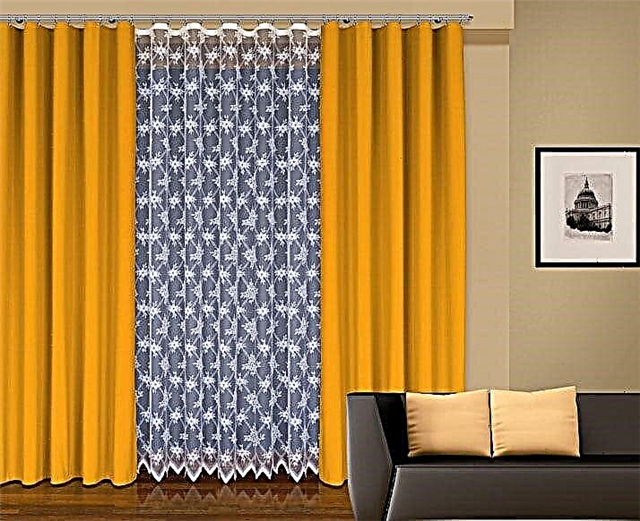
- Green gamut is self-sufficient. Light green tulle curtains will shade curtains of a darker shade: plain, with a pattern or embossed inhomogeneous (glossy and matte) surface of the material. This color is used by designers for all rooms, it calms, pacifies, and rich and vibrant tones of green look elegant and fun.
- Turquoise colors of curtains are emphasized by white tulle. This is one of the favorite and often played combinations of the Mediterranean style or provence. Bright, deep gamut of turquoise is appropriate in the living room, a touch of solemnity will add satin, shiny materials, muted colors will fill the nursery with freshness.
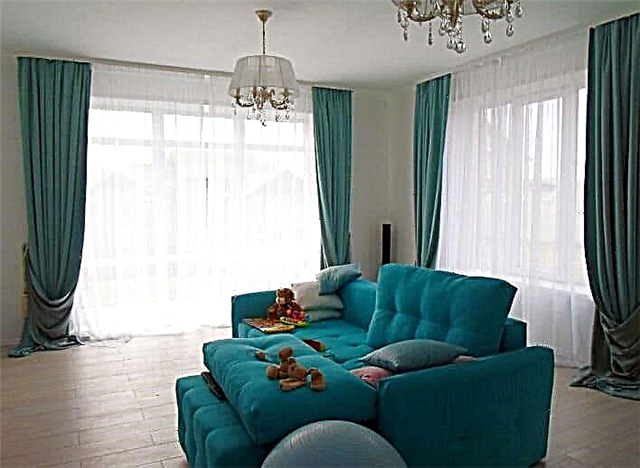
- Blue color is suitable for the bedroom. To soften the feeling of coolness, use warmer types of tulle for curtains.
- Bright, rich red color of curtains will soften the soft colors of tulle. But due to aggressiveness, you get tired of this combination over time. The design often uses a muffled, deep gamut of red (burgundy, dark purple). You can pick up tulle and curtains in the hall in such a combination, decorate an office or dining room.
- The orange and its derivatives are universal in its application. You can combine the tulle and curtains of this palette in any way, varying the mood and character of the room.
Warm, life-affirming color is used in all rooms. Brown curtains will add sternness and elegance to him. In combination with a green scale, it is suitable for a fun and carefree nursery. Universal and shining white accentuate the elegance and originality of design.
Types of Tulle
The most obvious option is light, airy translucent fabrics. They are suitable for curtains of any density.
Tulle Net represents an integral cloth collected from small graceful cells. This tulle looks very sophisticated and gentle, it goes well with dense curtains.
Organza Designers have long been fond of originality. However, choosing this material, it is worth remembering that soft folds on such a tulle will not work, because organza is a fairly dense material. But its brilliance can not be compared with anything, only for it’s worth choosing an organza. Such a tulle is suitable for curtains made of dense material with the design of any complexity.
Color Matching Rules
Curtains have long become an integral part of the interior of any room. They help complete the design and enrich the exterior decoration of the room. Agree, without curtains the room often looks poor, ugly. Photos of curtains with tulle and rooms without them perfectly visualize this statement.




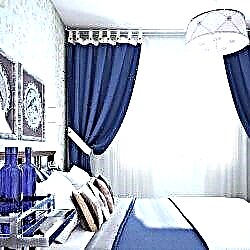




With the help of them you can remove some defects in the repair and completely redo the situation. The main thing is to know how to correctly combine the color of curtains with the overall decor of the room. In addition, you should learn about the correct combination of curtains with tulle. If they unsuccessfully interact with each other, then this can ruin the whole appearance.

Basically, the issue of color is based on two pillars: harmony and contrast. If in the first case the emphasis is shifted to the main color of the curtains, the tulle is selected with a more delicate light shade, then the contrast of two window details implies the choice of the opposite colors of the curtains and tulle.

As for the window drapery itself, it is selected for furniture and wall decoration. Drapery should interact with the upholstery (it is desirable that the fabric was similar), if the same texture is not obtained, they try to focus on the same pattern, the shade of the curtains, the bedspread, the covers for armchairs. If you constantly change the curtains during the repair, it is better to select them for the wallpaper.

If you like to use dense massive curtains in the design of the room, which in their design have a lot of decorative elements, then it is better to supplement them with a transparent, weightless tulle without a pattern. And vice versa: when using airy, plain curtains, you will need a massive and textured tulle.









There are certain points that must be taken into account when making a choice:

Curtains and tulle must match the style of the room. You must admit that curtains that will be dense, embroidered with gold with large whales, obviously will not fit the hi-tech style or postmodernism, like the Roman curtain with tulle. If you choose classics, then curtains and tulle with draperies will do. Provence will require elegant floral motifs.

Pay attention to the ductility and texture of the material. If you want ready-made curtains to look as impressive as possible, and they can be easily draped, the fabric should be soft and keep in shape. Only this will help to make beautiful folds.









Be wary of choosing a white tulle. It is not suitable for all rooms, because it looks very cold and solemn.

If there is too little sunlight in the room, then the curtains should be weightless and translucent so as not to impede the entry of those few direct rays.

Consider the color scheme, choosing curtains and tulle. Warm, light shades will visually increase the room, and dark, on the contrary, will make it smaller. If you want to choose bright colors, the overall design should not be catchy, otherwise the room will look too colorful.









Fabric selection
As for tulle, the modern fabric market offers a very large number of textures. Among them are organza, veil, mesh. These three materials are now the most popular.

Organza is made of polyester. It is good because it is very dense, but it looks weightless and airy. Organza passes the sun's rays, dries very quickly, drapes and is not a dust collection. Its only drawback is that it does not allow fresh air to pass through well.

As for the grid, it also allows sunlight to pass through well, but the dust settles on it very quickly, so the grid will quickly darken.

The veil is chosen by drapery lovers, because it is soft and durable. The problem with this material is that it transmits sunlight rather poorly if it has drawings or ornaments on it.

Material for curtains
You can choose curtains with tulle for the hall from natural or artificial fabrics. When choosing, it is necessary to build on criteria such as durability, practicality, moisture absorption, wear resistance and combustibility of curtains. The main types of tissue include the following:









Cotton - today this fabric is called the most practical. Curtains on the grommets of this material will last you a very long time. They are convenient to use, because they do not attract dust and are not electrified.



If you follow the conditions for proper washing, then they can be washed quite often. The only disadvantage of this texture is the yellowing of the fabric in direct sunlight.

Very often today curtains made of silk are used. They make the decoration of the room luxurious, because they are beautifully draped and flow to the floor with soft folds. The material has a high level of strength, is not electrified. In addition, they will never start a mole.

However, the material is quite finicky. It is difficult to wash, dry and iron such sets of curtains with tulle.
Problem
When buying or ordering curtains, many are guided by the width of the wall, for example, 200 cm. And they completely forget about the folds, which significantly reduce the size of the finished canvas.
As a result, two curtains do not reach each other in the center of the window and the sun or the light of a street lamp constantly enters the room.
Decision
The width of the canvas is determined by the length of the cornice and the type of curtain attachment desired. To calculate how much tissue is needed, you need to know build factor.
INMYROOM tip: when calculating the width of the curtains on both sides, you need to add another 10 cm to the hem of the sides, if you plan to sew the curtains yourself.






